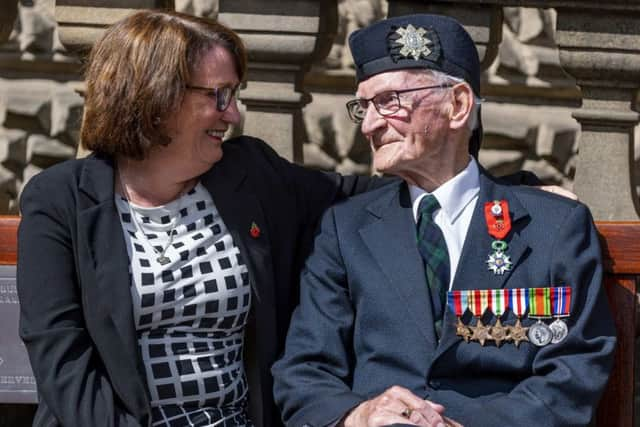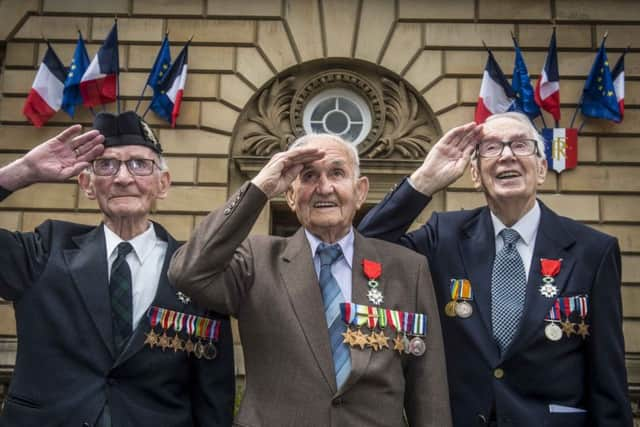Falkirk veteran Jack, 100, toasts D Day victory with French allies
and live on Freeview channel 276
His medals are a tour guide of some of the war’s fiercest fields of conflict - North Africa, Sicily, Italy, France, and, finally, Germany.
He could easily have been killed or badly wounded in any of these places, but this week - cheered on by his large and adoring family - he was one of a band of veterans to attend a very special commemoration event at the French Consulate in Edinburgh, co-organised with Legion Scotland.
Advertisement
Hide AdAdvertisement
Hide AdJack, brought up in Wallace Street, had already received France’s highest order of merit, the Légion d’honneur, at a ceremony in Edinburgh last year, a golden day of celebration in which Jack, as his sister Morag recalls, was “like a film star”.


He certainly didn’t feel like one on that fateful day in June, 1944, when he found he had to wade ashore to the Normandy beaches, after scrambling down a rope ladder in battledress and full kit, because the vessel he was in couldn’t get close in.
Yesterday he told the BBC it had been an anxious time, because at just 5ft 5ins he had to battle the current with rifle held high over his head while lugging a heavy pack - and live grenades.
Many comrades did not survive to see the victory in 1945, and yesterday Jack made the point - feelingly - that any “glory” (he questions the word) must be theirs.
Advertisement
Hide AdAdvertisement
Hide AdBut his full story, which like most veterans he will never tell in detail, could fill one very action-packed book, because Jack was serving with one of the most famous battalions of the British Army.


His unit was 1st Battalion, the Black Watch, also known as the Royal Highland Regiment and, colloquially, as the Forty-Twa’ (it was the 42nd regiment of the Line in olden days) - and as the Red Hackles, after the unique red feather plume worn in the soldiers’ bonnets.
They were a corps d’elite back in the 18th century, when they cut their teeth fighting the Jacobites, and were involved in virtually every campaign of consequence since then - their enemies ranged from George Washington to Napoleon (who ironically founded the Légion d’honneur).
In 1944, free of the hell of the first days’ desperate fighting for the beachheads, the Black Watch set off on the long, hard road that led to the leprous heart of Hitler’s Reich.
Advertisement
Hide AdAdvertisement
Hide AdThey played their part in the operations which led to the near annihalation of a German army in the Falaise Pocket, and were also involved in the effort to contain and finally defeat the desperate Nazi winter offensive through the Ardennes.
Then, the military histories tell us, the Forty-Twa’ were the very first Allied unit to cross the Rhine.
Jack does not dwell on the details. As ever he chiefly remembers those who did not come back.
However for his family the D Day commemoration has been a magnificent follow-up to last year’s celebration, when Jack was still only 99.
Advertisement
Hide AdAdvertisement
Hide AdEarlier this year there was real family joy (see video) - and a military piper - to celebrate Jack’s 100th birthday.
The end of the war in Europe was the beginning of a new family life.
He had been granted a 48-hour pass to marry his late wife Isabelle in 1944, and in 1946 the pair moved to Dundas Street in Grangemouth.
Jack worked as an iron moulder in Falkirk Foundry, and later joined ICI in Grangemouth.
Advertisement
Hide AdAdvertisement
Hide AdThe couple then moved to Falkirk’s Campbell Street, where they brought up their children Johnny (the eldest), May, Morag and Lorraine, and after Isabelle sadly passed away aged 67 Jack relocated to the town’s Bantaskine Street.
What, looking back on the 75 years since D Day, does Jack think about this week’s commemoration?
Of the war itself, with its gallery of names whose names are painted in blood - Tobruk, Monte Cassino, Dunkirk, to name just a few - he says simply: “It does not bear thinking about if you’ve not seen it.
“(Commemorations) are very important, because it lets the younger generations know what the lads went through”.